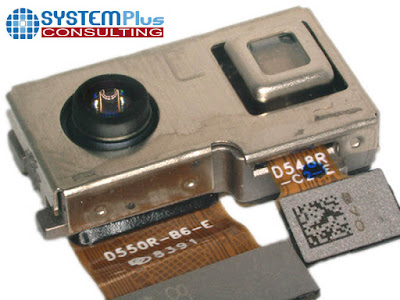SystemPlus publishes a reverse engineering report of Panasonic ToF module found in Vino Nex Dual Display smartphone:
"For 3D depth sensing, three approaches have been considered in consumer applications: active stereo vision (AS), structured light (SL) and Time-Of-Flight (ToF) sensing. SL was developed by Apple, which brought it to the market for the first time in 2017. It’s based on a complex system requiring several components, including a Global Shutter (GS) image sensor and a dot projector. The latter has been considered difficult and expensive to make due to the precision required. The ToF approach could be less complex and less expensive. You just need a ToF Image sensor and a flood illuminator to bring depth sensing to a system. In this field, only three known companies have solutions. In 2016, Infineon was the first to bring out its 3D ToF image sensor, developed with pmd, for the Google Tango Project. Today, Sony has the major share of the market with several design wins starting from low-end smartphones, such as the Oppo RX17 Pro in 2018, to high-end ones, such as the Samsung S10 5G and Huawei P30 Pro in 2019. This year, Panasonic has surprised the market with a new ToF Image Sensor in the Vivo Nex Dual Display."




Did anyone look at the report? What's the pixel looking like? Photogate like MESA/PMD, or CAPDs like Sony? Or rather PPD based like old ST/IMS etc?
ReplyDeleteIt's CCD sensor. Probably, the last CCD survived in smartphones.
DeleteOh wow, so drivers, ADC and all off-chip? Oh boy, must be really slow and poor performance!?
DeleteAll this stuff can be integrated onto a single chip, such as this one:
Deletehttps://www.analog.com/media/en/technical-documentation/data-sheets/AD9923A.pdf
I see, thanks for sharing. I was just thinking at the reduced bandwidth for modulation drivers due to being off-chip and the same for the ADC. As you point out price and module size might not be terrible, but I expect the performance to lag behind other ToF modules for mobile such as from Sony or PMD...
DeleteBasler uses Panasonic CCDs, albeit in a completely different form factor and for a different applications. I'm not sure if these are the same CCDs, but you can see their claimed performance here:
Deletehttps://image-sensors-world.blogspot.com/2016/09/basler-tof-camera-nears-production.html
https://image-sensors-world.blogspot.com/2017/02/basler-tof-camera-promotional-video.html
http://image-sensors-world.blogspot.com/2014/12/basler-presents-tof-cameras-with.html
Timing requirements are quite severe, I wonder how such a system would cope with temperature drift of all those external components, not to mention the complex CCD power supply architecture. I would put my money on Sony CMOS for mass production.
ReplyDelete